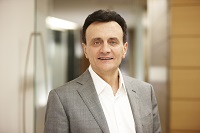 A 13% jump in the number of compounds in development at AstraZeneca ($AZN) has seen it leapfrog Pfizer ($PFE) to claim fourth place on Citeline's list of the biggest development pipelines. The switch means European Big Pharma companies occupy the top four spots, with GlaxoSmithKline ($GSK), Novartis ($NVS) and Roche ($RHHBY) taking the podium positions.
A 13% jump in the number of compounds in development at AstraZeneca ($AZN) has seen it leapfrog Pfizer ($PFE) to claim fourth place on Citeline's list of the biggest development pipelines. The switch means European Big Pharma companies occupy the top four spots, with GlaxoSmithKline ($GSK), Novartis ($NVS) and Roche ($RHHBY) taking the podium positions.
 |
| AstraZeneca CEO Pascal Soriot |
AstraZeneca has increased the size of its pipeline by 41% over the past two years, a period that starts around when Pascal Soriot took over as CEO. Soriot inherited a company that had suffered a string of pipeline failures as it tried to develop new drugs to steady sales during the patent cliff. The real tests of Soriot's turnaround strategy will come as drugs enter late-phase development, but the public perception and scale of AstraZeneca's pipeline have already shifted.
The pipeline boom was driven by in-house and third-party assets. Over the past two years, the proportion of drugs in AstraZeneca's pipeline that originated at its own labs has ticked up by a few percentage points to 55%. AstraZeneca is still far less reliant on its in-house labs than Eli Lilly ($LLY) or Novartis--which have respectively discovered 78% and 74% of the drugs in their pipelines--but is more productive than Sanofi ($SNY). The French drugmaker discovered 46% of the products in its pipeline.
AstraZeneca's advance to fourth spot on Citeline's pipeline leaderboard is one of several changes for European pharma companies. The expansion of Novartis' pipeline and trimming of Roche's assets caused the two Swiss companies to switch places, while Sanofi slipped one spot to eighth. For several years, Sanofi has kept around 180 different drugs in its pipeline at any given time, but expansions at AstraZeneca and Johnson & Johnson ($JNJ) have caused it to slide down the rankings.
- access the report (PDF)